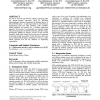BMCBI
2006
14 years 4 months ago
2006
Background: Agile is an iterative approach to software development that relies on strong collaboration and automation to keep pace with dynamic environments. We have successfully ...
CORR
2010
Springer
14 years 4 months ago
2010
Springer
Agile development processes and component-based software architectures are two software engineering approaches that contribute to enable the rapid building and evolution of applic...
BCSHCI
2007
14 years 6 months ago
2007
We seek to close the gap between software engineering (SE) and human-computer interaction (HCI) by indicating interdisciplinary interfaces throughout the different phases of SE an...
CAISE
2008
Springer
14 years 6 months ago
2008
Springer
Agile Modeling provides a set of best practices of "light-weight" modeling to support the modeling process on a macro level within the agile development teams. The object...
AGILEDC
2004
IEEE
2004
IEEE
Aligning Strategic Planning with Agile Development: Extending Agile Thinking to Business Improvement
14 years 8 months ago
Many development teams have successfully used Agile Development to build quality software, but often these projects have failed to effectively contribute to overall company succes...
ESEM
2007
ACM
14 years 8 months ago
2007
ACM
Agile development methodologies have been gaining acceptance in the mainstream software development community. While there are numerous studies of Agile development in academic an...
AGILEDC
2003
IEEE
14 years 10 months ago
2003
IEEE
One of the myths of Agile Development is that selforganizing teams do not need direction. The agile development movement focuses primarily on programmers – programmers should do...
NSPW
2004
ACM
14 years 10 months ago
2004
ACM
Agile development methodologies are gaining acceptance in the software industry. If they are to be used for constructing securitycritical solutions, what do we do about assurance?...
AGILEDC
2005
IEEE
14 years 10 months ago
2005
IEEE
Both agile development and User Centered Design stress collaboration between customers and product teams, but getting these methodologies to work well together is not easy. This p...
AGILEDC
2005
IEEE
14 years 10 months ago
2005
IEEE
Doing agile development in a relatively inelastic environment, where policies and procedures are virtually unchangeable, creates an impedance mismatch between the agile team and i...


